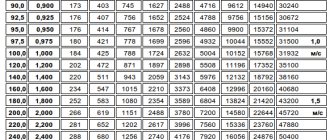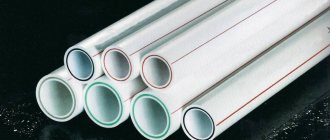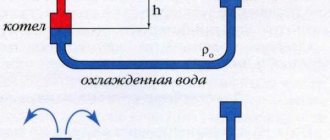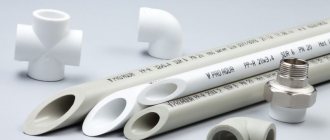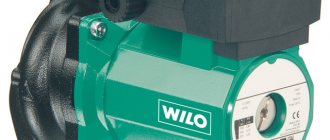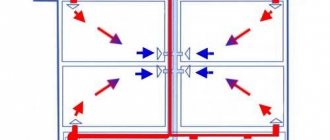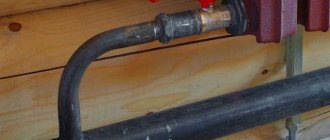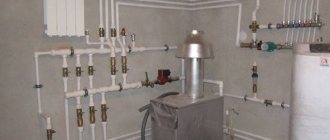Heating water speed rate
Diameter of pipelines, flow velocity and coolant flow rate.
This material is intended to understand what the diameter, flow rate and flow rate are. And what are the connections between them. In other materials, there will be a detailed calculation of the diameter for heating.
In order to calculate the diameter, you need to know:
| 1. The flow rate of the coolant (water) in the pipe. 2. Resistance to the movement of the coolant (water) in a pipe of a certain length. |
Here are the necessary formulas to know:
| S-Sectional area m 2 of the internal lumen of the pipe π-3,14-constant - the ratio of the circumference to its diameter. r-Radius of a circle equal to half the diameter, m Q-water flow rate m 3 / s D-Internal pipe diameter, m V-coolant flow velocity, m / s |
Resistance to the movement of the coolant.
Any coolant moving inside the pipe strives to stop its movement. The force that is applied to stop the movement of the coolant is the resistance force.
This resistance is called pressure loss. That is, the moving heat carrier through a pipe of a certain length loses pressure.
The head is measured in meters or in pressures (Pa). For convenience, it is necessary to use meters in the calculations.
In order to better understand the meaning of this material, I recommend following the solution of the problem.
In a pipe with an inner diameter of 12 mm, water flows at a speed of 1 m / s. Find the expense.
Decision:
You must use the above formulas:
| 1. Find the cross section 2. Find the flow |
| D = 12mm = 0.012 m p = 3.14 |
S = 3.14 • 0.012 2/4 = 0.000113 m 2
Q = 0.000113 • 1 = 0.000113 m 3 / s = 0.4 m 3 / h.
There is a pump with a constant flow rate of 40 liters per minute. A 1 meter pipe is connected to the pump. Find the inner diameter of the pipe at a water speed of 6 m / s.
Q = 40l / min = 0.000666666 m 3 / s
From the above formulas I got the following formula.
Each pump has the following flow-resistance characteristic:
This means that our flow rate at the end of the pipe will depend on the head loss that is created by the pipe itself.
| The longer the pipe, the greater the head loss. The smaller the diameter, the greater the head loss. The higher the speed of the coolant in the pipe, the greater the head loss. Corners, bends, tees, narrowing and widening of the pipe also increase the head loss. |
The head loss along the length of the pipeline is discussed in more detail in this article:
Now let's look at a task from a real-life example.
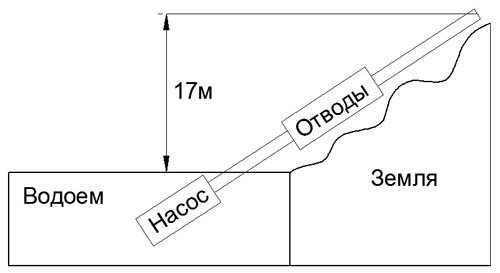
The steel (iron) pipe is laid with a length of 376 meters with an inner diameter of 100 mm, along the length of the pipe there are 21 branches (90 ° C bends). The pipe is laid with a drop of 17m. That is, the pipe goes up to a height of 17 meters relative to the horizon. Pump characteristics: Maximum head 50 meters (0.5MPa), maximum flow 90m 3 / h. Water temperature 16 ° C. Find the maximum possible flow rate at the end of the pipe.
| D = 100 mm = 0.1 m L = 376 m Geometrical height = 17 m Elbows 21 pcs Pump head = 0.5 MPa (50 meters of water column) Maximum flow = 90 m 3 / h Water temperature 16 ° C. Steel iron pipe |
Find the maximum flow rate =?
Solution on video:
To solve it, you need to know the pump schedule: Dependence of flow rate on head.
In our case, there will be a graph like this:
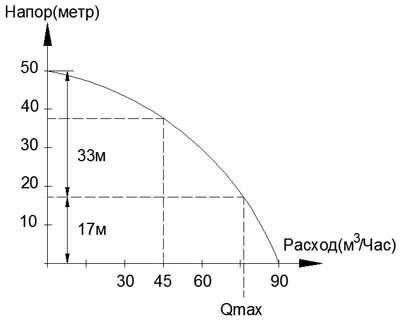

Look, I marked 17 meters with a dashed line on the horizon and at the intersection along the curve I get the maximum possible flow rate: Qmax.
According to the schedule, I can safely say that at the height difference, we lose approximately: 14 m 3 / hour.(90-Qmax = 14 m 3 / h).
The stepwise calculation is obtained because the formula contains a quadratic feature of head losses in dynamics (movement).
Therefore, we solve the problem stepwise.
Since we have a flow rate range from 0 to 76 m 3 / h, I would like to check the head loss at a flow rate equal to: 45 m 3 / h.
Finding the speed of water movement
Q = 45 m 3 / h = 0.0125 m 3 / sec.
V = (4 • 0.0125) / (3.14 • 0.1 • 0.1) = 1.59 m / s
Finding the Reynolds number
ν = 1.16 x 10 -6 = 0.00000116. Taken from the table. For water at a temperature of 16 ° C.
Δe = 0.1mm = 0.0001m. Taken from the table for a steel (iron) pipe.
Further, we check the table, where we find the formula for finding the coefficient of hydraulic friction.
I get to the second area under the condition
10 • D / Δe 0.25 = 0.11 • (0.0001 / 0.1 + 68/137069) 0.25 = 0.0216
Next, we finish with the formula:
h = λ • (L • V 2) / (D • 2 • g) = 0.0216 • (376 • 1.59 • 1.59) / (0.1 • 2 • 9.81) = 10.46 m.
As you can see, the loss is 10 meters. Next, we determine Q1, see the graph:
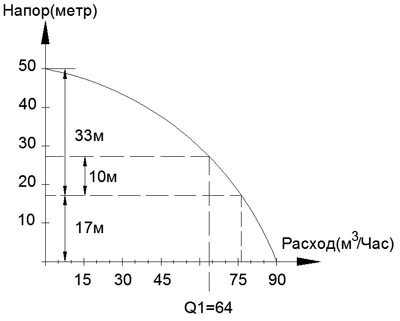

Now we do the original calculation at a flow rate equal to 64m 3 / hour
Q = 64 m 3 / h = 0.018 m 3 / sec.
V = (4 • 0.018) / (3.14 • 0.1 • 0.1) = 2.29 m / s
λ = 0.11 (Δe / D + 68 / Re) 0.25 = 0.11 • (0.0001 / 0.1 + 68/197414) 0.25 = 0.021
h = λ • (L • V 2) / (D • 2 • g) = 0.021 • (376 • 2.29 • 2.29) / (0.1 • 2 • 9.81) = 21.1 m.
We mark on the chart:
Qmax is at the intersection of the curve between Q1 and Q2 (Exactly the middle of the curve).
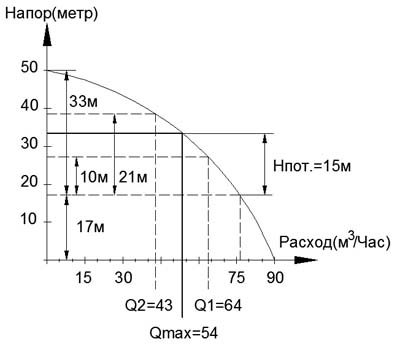

Answer: The maximum flow rate is 54 m 3 / h. But we decided this without resistance on the bends.
To check, check:
Q = 54 m 3 / h = 0.015 m 3 / sec.
V = (4 • 0.015) / (3.14 • 0.1 • 0.1) = 1.91 m / s
λ = 0.11 (Δe / D + 68 / Re) 0.25 = 0.11 • (0.0001 / 0.1 + 68/164655) 0.25 = 0.0213
h = λ • (L • V 2) / (D • 2 • g) = 0.0213 • (376 • 1.91 • 1.91) / (0.1 • 2 • 9.81) = 14.89 m.
Result: We hit Npot = 14.89 = 15m.
Now let's calculate the cornering resistance:
The formula for finding the head at the local hydraulic resistance:
| h-head loss here it is measured in meters. ζ is the coefficient of resistance. For a knee, it is approximately equal to one if the diameter is less than 30mm. V is the fluid flow rate. Measured by [Meter / Second]. g-acceleration due to gravity is 9.81 m / s2 |
ζ is the coefficient of resistance. For a knee, it is approximately equal to one if the diameter is less than 30mm. For larger diameters, it decreases. This is due to the fact that the influence of the speed of movement of the water in relation to the turn is reduced.
Looked in different books on local resistances for turning pipes and bends. And he often came to the calculations that one strong sharp turn is equal to the coefficient of unity. A sharp turn is considered if the turning radius does not exceed the diameter by value. If the radius exceeds the diameter by 2-3 times, then the value of the coefficient decreases significantly.
Speed 1.91 m / s
h = ζ • (V 2) / 2 • 9.81 = (1 • 1.91 2) / (2 • 9.81) = 0.18 m.
We multiply this value by the number of taps and get 0.18 • 21 = 3.78 m.
Answer: at a speed of 1.91 m / s, we get a head loss of 3.78 meters.
Let's now solve the whole problem with taps.
At a flow rate of 45 m 3 / h, a head loss along the length was obtained: 10.46 m. See above.
At this speed (2.29 m / s) we find the resistance when cornering:
h = ζ • (V 2) / 2 • 9.81 = (1 • 2.29 2) / (2 • 9.81) = 0.27 m. multiply by 21 = 5.67 m.
Add the head losses: 10.46 + 5.67 = 16.13m.
We mark on the chart:
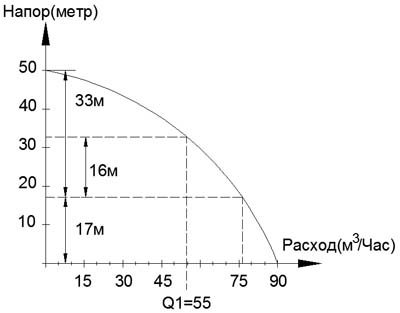

We solve the same only for a flow rate of 55 m 3 / h
Q = 55 m 3 / h = 0.015 m 3 / sec.
V = (4 • 0.015) / (3.14 • 0.1 • 0.1) = 1.91 m / s
λ = 0.11 (Δe / D + 68 / Re) 0.25 = 0.11 • (0.0001 / 0.1 + 68/164655) 0.25 = 0.0213
h = λ • (L • V 2) / (D • 2 • g) = 0.0213 • (376 • 1.91 • 1.91) / (0.1 • 2 • 9.81) = 14.89 m.
h = ζ • (V 2) / 2 • 9.81 = (1 • 1.91 2) / (2 • 9.81) = 0.18 m. multiply by 21 = 3.78 m.
Add losses: 14.89 + 3.78 = 18.67 m
Drawing on the chart:
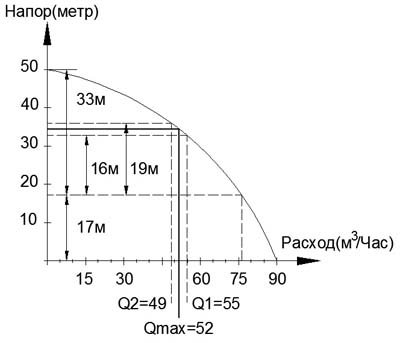

Answer:
Maximum flow rate = 52 m 3 / hour. Without bends Qmax = 54 m 3 / hour.
As a result, the size of the diameter is influenced by:
| 1. Resistance created by the pipe with bends 2. Required flow 3. Influence of the pump by its flow-pressure characteristic |
If the flow rate at the end of the pipe is less, then it is necessary: Either increase the diameter, or increase the pump power. It is not economical to increase the pump power.
This article is part of the system: Water heating constructor
Hydraulic calculation of the heating system, taking into account pipelines.
Hydraulic calculation of the heating system, taking into account pipelines.
When carrying out further calculations, we will use all the main hydraulic parameters, including the flow rate of the coolant, hydraulic resistance of fittings and pipelines, the speed of the coolant, etc. There is a complete relationship between these parameters, which is what you need to rely on in the calculations.
For example, if the speed of the coolant is increased, the hydraulic resistance at the pipeline will increase at the same time.If the flow rate of the coolant is increased, taking into account the pipeline of a given diameter, the speed of the coolant will simultaneously increase, as well as the hydraulic resistance. And the larger the diameter of the pipeline, the lower the speed of the coolant and the hydraulic resistance. Based on the analysis of these relationships, it is possible to turn the hydraulic calculation of the heating system (the calculation program is in the network) into an analysis of the parameters of the efficiency and reliability of the entire system, which, in turn, will help reduce the cost of the materials used.
The heating system includes four basic components: a heat generator, heating devices, piping, shut-off and control valves. These elements have individual parameters of hydraulic resistance, which must be taken into account when calculating. Recall that the hydraulic characteristics are not constant. Leading manufacturers of materials and heating equipment must provide information on specific pressure losses (hydraulic characteristics) for the equipment or materials produced.
For example, the calculation for polypropylene pipelines from FIRAT is greatly facilitated by the given nomogram, which indicates the specific pressure or head loss in the pipeline for 1 meter of running pipe. Analysis of the nomogram allows you to clearly trace the above relationships between individual characteristics. This is the main essence of hydraulic calculations.
Hydraulic calculation of hot water heating systems: heat carrier flow
We think you have already drawn an analogy between the term "coolant flow" and the term "amount of coolant". So, the flow rate of the coolant will directly depend on what heat load falls on the coolant in the process of transferring heat to the heating device from the heat generator.
Hydraulic calculation implies the determination of the level of the coolant flow rate in relation to a given area. The calculated section is a section with a stable coolant flow rate and a constant diameter.
Hydraulic calculation of heating systems: example
If the branch includes ten kilowatt radiators, and the coolant consumption was calculated for the transfer of heat energy at the level of 10 kilowatts, then the calculated section will be a cut from the heat generator to the radiator, which is the first in the branch. But only on condition that this area is characterized by a constant diameter. The second section is located between the first radiator and the second radiator. At the same time, if in the first case the consumption of 10-kilowatt heat energy transfer was calculated, then in the second section the calculated amount of energy will already be 9 kilowatts, with a gradual decrease as the calculations are carried out. The hydraulic resistance must be calculated simultaneously for the supply and return pipelines.
Hydraulic calculation of a one-pipe heating system involves calculating the flow rate of the heat carrier
for the calculated area according to the following formula:
Quch is the thermal load of the calculated area in watts. For example, for our example, the heat load on the first section will be 10,000 watts or 10 kilowatts.
s (specific heat capacity for water) - constant equal to 4.2 kJ / (kg • ° С)
tg is the temperature of the hot heat carrier in the heating system.
tо is the temperature of the cold heat carrier in the heating system.
Hydraulic calculation of the heating system: flow rate of the heating medium
The minimum speed of the coolant should take a threshold value of 0.2 - 0.25 m / s. If the speed is lower, excess air will be released from the coolant. This will lead to the appearance of air locks in the system, which, in turn, can cause partial or complete failure of the heating system.As for the upper threshold, the speed of the coolant should reach 0.6 - 1.5 m / s. If the speed does not rise above this indicator, then hydraulic noise will not form in the pipeline. Practice shows that the optimal speed range for heating systems is 0.3 - 0.7 m / s.
If there is a need to calculate the speed range of the coolant more accurately, then you will have to take into account the parameters of the material of the pipelines in the heating system. More precisely, you need a roughness factor for the inner piping surface. For example, if we are talking about pipelines made of steel, then the optimal speed of the coolant is at the level of 0.25 - 0.5 m / s. If the pipeline is polymer or copper, then the speed can be increased to 0.25 - 0.7 m / s. If you want to play it safe, read carefully what speed is recommended by manufacturers of equipment for heating systems. A more accurate range of the recommended speed of the coolant depends on the material of the pipelines used in the heating system, and more precisely on the roughness coefficient of the inner surface of the pipelines. For example, for steel pipelines, it is better to adhere to the coolant speed from 0.25 to 0.5 m / s for copper and polymer (polypropylene, polyethylene, metal-plastic pipelines) from 0.25 to 0.7 m / s, or use the manufacturer's recommendations if available.
Calculation of the hydraulic resistance of the heating system: pressure loss
The loss of pressure in a certain section of the system, which is also called the term "hydraulic resistance", is the sum of all losses due to hydraulic friction and in local resistances. This indicator, measured in Pa, is calculated by the formula:
ΔPuch = R * l + ((ρ * ν2) / 2) * Σζ
ν is the speed of the used coolant, measured in m / s.
ρ is the density of the heat carrier, measured in kg / m3.
R is the pressure loss in the pipeline, measured in Pa / m.
l is the estimated length of the pipeline in the section, measured in m.
Σζ is the sum of the coefficients of local resistances in the area of equipment and shut-off and control valves.
As for the total hydraulic resistance, it is the sum of all hydraulic resistances of the calculated sections.
Hydraulic calculation of a two-pipe heating system: selection of the main branch of the system
If the system is characterized by a passing movement of the coolant, then for a two-pipe system, the ring of the most loaded riser is selected through the lower heating device. For a one-pipe system, a ring through the busiest riser.
The main characteristics of the heating medium for heating
It is possible to determine in advance the flow rate of the coolant in the heating system only after analyzing its technical and operational parameters. They will affect the characteristics of the entire heat supply, as well as affect the operation of other elements.
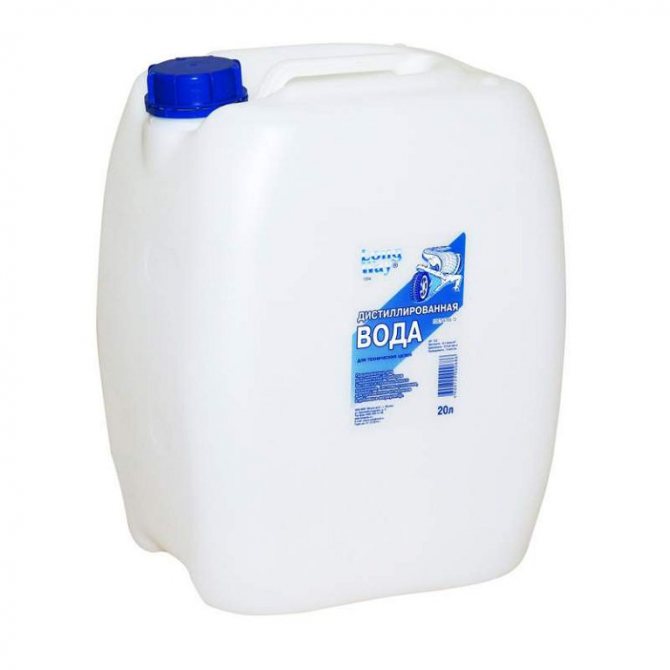

Distilled water for heating
Since the properties of antifreezes depend on their composition and the content of additional impurities, technical parameters for distilled water will be considered. For heat supply, it is the distillate that should be used - completely purified water. When comparing heat transfer fluids for heating systems, it can be determined that the flowing liquid contains a large number of third-party components. They negatively affect the operation of the system. After use during the season, a layer of scale builds up on the inner surfaces of pipes and radiators.
To determine the maximum temperature of the coolant in the heating system, one should pay attention not only to its properties, but also to the limitations in the operation of pipes and radiators. They should not suffer from increased heat exposure.
Consider the most significant characteristics of water as a coolant for aluminum heating radiators:
- Heat capacity - 4.2 kJ / kg * C;
- Bulk density... At an average temperature of + 4 ° C, it is 1000 kg / m³.However, during heating, the specific gravity begins to decline. Upon reaching + 90 ° С it will be equal to 965 kg / m³;
- Boiling temperature... In an open heating system, water boils at a temperature of + 100 ° C. However, if you increase the pressure in the heat supply to 2.75 atm. - the maximum temperature of the heat carrier in the heat supply system can be + 130 ° С.
An important parameter in the operation of heat supply is the optimal speed of the coolant in the heating system. It directly depends on the diameter of the pipelines. The minimum value should be 0.2-0.3 m / s. The maximum speed is not limited by anything. It is important that the system maintains the optimal temperature of the heating medium in the heating along the entire circuit and there are no extraneous noises.
However, professionals prefer to be guided by the holes of the old SNiP of 1962. It indicates the maximum values of the optimal speed of the coolant in the heat supply system.
| Pipe diameter, mm | Maximum water speed, m / s |
| 25 | 0,8 |
| 32 | 1 |
| 40 and more | 1,5 |
Exceeding these values will affect the flow rate of the heating medium in the heating system. This can lead to an increase in hydraulic resistance and "false" operation of the drain safety valve. It should be remembered that all parameters of the heat carrier of the heat supply system must be pre-calculated. The same applies to the optimal temperature of the coolant in the heat supply system. If a low-temperature network is being designed, you can leave this parameter empty. For classic schemes, the maximum heating value of the circulating fluid directly depends on the pressure and restrictions on pipes and radiators.
For the correct choice of a coolant for heating systems, a temperature schedule for the operation of the system is preliminarily drawn up. The maximum and minimum values of water heating should not be lower than 0 ° С and above + 100 ° С
The speed of movement of water in the pipes of the heating system.
At the lectures, we were told that the optimal speed of water movement in the pipeline is 0.8-1.5 m / s. On some sites I see something like that (specifically about the maximum one and a half meters per second).
BUT in the manual it is said to take losses per running meter and speed - according to the application in the manual. There, the speeds are completely different, the maximum, which is in the plate - just 0.8 m / s.
And in the textbook I met an example of calculation, where the speeds do not exceed 0.3-0.4 m / s.
Duck, what's the point? How to accept it at all (and how in reality, in practice)?
I attach a screen of the tablet from the manual.
Thank you in advance for your answers!
What do you want? To learn the "military secret" (how to actually do it), or to pass the course book? If only a term student - then according to the manual that the teacher wrote and knows nothing else and does not want to know. And if you do how to
, will not accept yet.
0.036 * G ^ 0.53 - for heating risers
0.034 * G ^ 0.49 - for branch lines, until the load decreases to 1/3
0.022 * G ^ 0.49 - for the end sections of a branch with a load of 1/3 of the entire branch
In the course book, I counted it like a manual. But I wanted to know how the situation was.
That is, it turns out in the textbook (Staroverov, M. Stroyizdat) is also not correct (speeds from 0.08 to 0.3-0.4). But perhaps there is only an example of calculation.
Offtop: That is, you also confirm that, in fact, the old (relatively) SNiPs are in no way inferior to the new ones, and somewhere even better. (Many teachers tell us about this. On the PSP, the dean says that their new SNiP in many ways contradicts both the laws and himself).
But in principle, they explained everything.
and the calculation for a decrease in diameters along the flow seems to save materials. but increases labor costs for installation. if labor is cheap, it might make sense. if labor is expensive, there is no point. And if, at a large length (heating main), changing the diameter is profitable, fussing with these diameters does not make sense within the house.
and there is also the concept of hydraulic stability of the heating system - and here ShaggyDoc schemes win
We disconnect each riser (upper wiring) with a valve from the main. Duck just met that right after the valve they put double adjustment taps. Is it advisable?
And how to disconnect the radiators themselves from the connections: valves, or put a double-adjustment tap, or both? (that is, if this crane could completely shut off the corpse pipeline, then the valve is not needed at all?)
And for what purpose are the sections of the pipeline isolated? (designation - spiral)
The heating system is two-pipe.
I specifically find out about the supply pipeline, the question is above.
We have a coefficient of local resistance at the inlet of a flow with a turn. Specifically, we apply it to the entrance through a louver into a vertical channel. And this coefficient is equal to 2.5 - which is quite a lot.
I mean, how to come up with something to get rid of it. One of the exits - if the grating is “in the ceiling”, and then there will be no entrance with a turn (although it will be small, since the air will be drawn along the ceiling, moving horizontally, and move towards this grating, turn in a vertical direction, but along logic, this should be less than 2.5).
In an apartment building, you can't make a grating in the ceiling, neighbors. and in a single-family apartment - the ceiling will not be beautiful with a lattice, and debris can get in. that is, the problem cannot be solved that way.
I often drill, then I plug it
Take heat output and start from end temperature. Based on this data, you will absolutely reliably calculate
speed. It will most likely be 0.2 mS maximum. Higher speeds - you need a pump.
Calculation of the diameter of the pipes of the heating system
This calculation is based on a number of parameters. First you need to define thermal power of the heating system
, then calculate at what speed the coolant - hot water or another type of coolant - will move through the pipes. This will help make calculations as accurate as possible and avoid inaccuracies.
Calculation of the power of the heating system
The calculation is made according to the formula. To calculate the power of the heating system, you need to multiply the volume of the heated room by the heat loss coefficient and by the difference between the winter temperature inside the room and outside, and then divide the resulting value by 860.
The heat loss coefficient can be determined based on the building material, as well as the availability of insulation methods and its types.
If the building has standard parameters
, then the calculation can be made in an averaged order.
To determine the resulting temperature, it is necessary to have an average outside temperature in the winter season and an internal temperature not less than it is regulated by sanitary requirements.
Coolant speed in the system
According to the standards, the speed of movement of the coolant through the heating pipes should exceed 0.2 meters per second
... This requirement is due to the fact that at a lower speed of movement, air is released from the liquid, which leads to air locks, which can disrupt the operation of the entire heating system.
The upper speed level should not exceed 1.5 meters per second, as this may cause noise in the system.
In general, it is desirable to maintain a medium speed barrier in order to increase circulation and thereby increase the productivity of the system. Most often, special pumps are used to achieve this.
Calculation of the pipe diameter of the heating system
Correct determination of the pipe diameter is a very important point, since it is responsible for the high-quality operation of the entire system and if an incorrect calculation is made and the system is mounted on it, then it will be impossible to partially correct something. It will be necessary replacement of the entire pipeline system.
And this is a significant expense. In order to prevent this, you need to approach the calculation with all responsibility.
The pipe diameter is calculated using special formula.
It includes:
- required diameter
- thermal power of the system
- coolant movement speed
- the difference between the temperature in the supply and return of the heating system.
This temperature difference must be selected based on entry standards
(not less than 95 degrees) and to the return (as a rule, it is 65-70 degrees). Based on this, the temperature difference is usually taken as 20 degrees.
Everyone should know the standards: parameters of the heating medium of the heating system of an apartment building
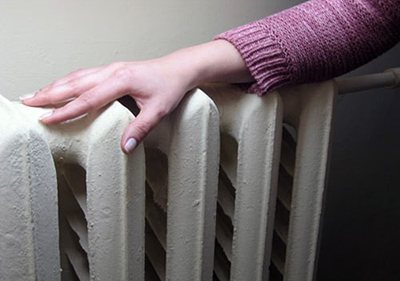

Residents of apartment buildings in the cold season more often trust the maintenance of the temperature in the rooms to the already installed batteries central heating.
This is the advantage of urban high-rise buildings over the private sector - from mid-October to the end of April, utilities take care of constant heating living quarters. But their work is not always perfect.
Many have encountered insufficiently hot pipes in winter frosts, and with a real heat attack in the spring. In fact, the optimal temperature of an apartment at different times of the year is determined centrally, and must comply with the accepted GOST.
Pressure
The diagonal type of connection is also called the lateral cross-circuit, because the water supply is connected on top of the radiator, and the return is organized at the bottom of the opposite side. It is advisable to use it when connecting a significant number of sections - with a small amount, the pressure in the heating system rises sharply, which can lead to undesirable results, that is, heat transfer can be halved.
To finally dwell on one of the options for connecting radiator batteries, it is necessary to be guided by the method of organizing the return. It can be of the following types: one-pipe, two-pipe and hybrid.
The option that is worth stopping at will directly depend on a combination of factors. It is necessary to take into account the number of storeys of the building where the heating is connected, the requirements for the price equivalent of the heating system, what type of circulation is used in the coolant, the parameters of the radiator batteries, their dimensions and much more.
Most often, they stop their choice on a single-pipe wiring diagram for heating pipes.
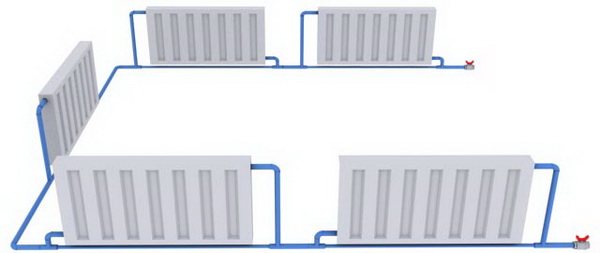

As practice shows, such a scheme is used precisely in modern high-rise buildings.
Such a system has a number of characteristics: they are of low cost, they are quite easy to install, the coolant (hot water) is supplied from above when choosing a vertical heating system.
Also, radiators are connected to the heating system in a sequential type, and this, in turn, does not require a separate riser for organizing the return. In other words, water, having passed the first radiator, flows into the next one, then into the third, and so on.
However, there is no way to regulate the uniform heating of the radiator batteries and its intensity; they constantly record a high coolant pressure. The further the radiator is installed from the boiler, the more the heat transfer decreases.
There is also a different wiring method - a 2-pipe scheme, that is, a heating system with a return flow. It is most often used in luxury housing or in an individual home.
Here is a pair of closed circuits, one of them is intended for supplying water to parallel-connected batteries, and the second for draining it.
Hybrid wiring combines the above two schemes. This can be a collector diagram, where an individual routing branch is organized at each level.
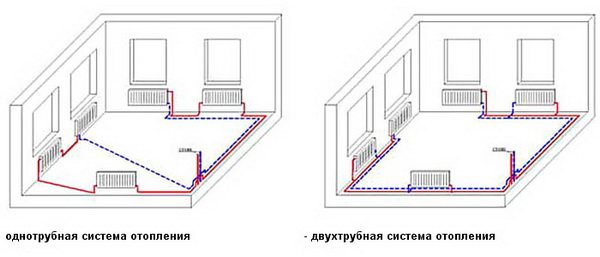

More on this topic on our website:
- How to fill a heating system with antifreeze - process and equipment Due to the non-toxicity of this liquid, it can be poured into the pipes of the heating system in a residential building. Even in the event of a liquid leak, it does not carry ...
- It is impossible to imagine a private house without heating. Of course, if this is not a summer cottage.Therefore, the question of how to mount the entire pipeline system, select equipment and conduct ...
- Although ordinary people believe that they do not need to know exactly what scheme is used to heat an apartment building, situations in life can really be different. For instance,…
- The choice of which coolant to buy for the heating system depends on the conditions of its operation. The type of boiler and pumping equipment, heat exchangers, etc. is also taken into account.
Heating standards PP RF No. 354 of 05/06/2011 and GOST
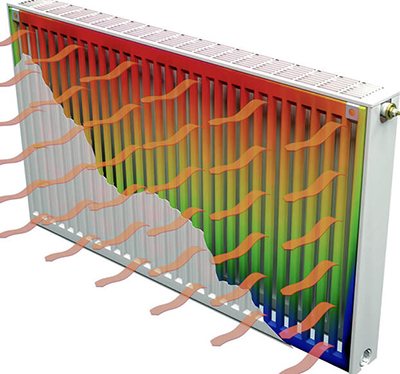

May 6, 2011 was published Government Decree, which is valid to this day. According to him, the heating season depends not so much on the season as on the air temperature outside.
The central heating starts to work, provided that the external thermometer shows the mark below 8 ° C, and the cold snap lasts at least five days.
On the sixth day the pipes are already starting to heat the premises. If warming occurs within the specified time, the heating season is postponed. In all parts of the country, batteries delight with their warmth from mid-autumn and maintain a comfortable temperature until the end of April.
If frost has come and the pipes remain cold, this may be the result system problems. In the event of a global breakdown or incomplete repair work, you will have to use an additional heater until the malfunction is eliminated.
If the problem lies in air locks that have filled the batteries, contact the operating company. Within 24 hours after submitting the application, a plumber assigned to the house will arrive and "blow through" the problem area.
The standard and norms of permissible air temperature values are spelled out in the document "GOST R 51617-200. Housing and communal services. General technical information ". The range of air heating in the apartment may vary from 10 to 25 ° C, depending on the purpose of each heated room.
- Living rooms, which include living rooms, study bedrooms and the like, must be heated to 22 ° C.Possible fluctuation of this mark up to 20 ° Cespecially in cold corners. The maximum value of the thermometer should not exceed 24 ° C.
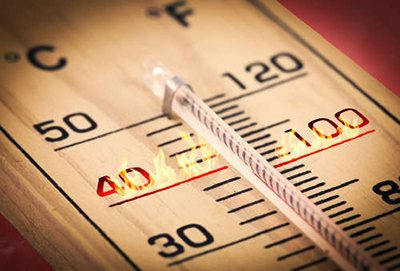

The temperature is considered optimal. from 19 to 21 ° C, but zone cooling is allowed up to 18 ° C or intense heating up to 26 ° C.
- The toilet follows the temperature range of the kitchen. But, a bathroom, or an adjoining bathroom, is considered to be rooms with a high level of humidity. This part of the apartment can warm up up to 26 ° Cand cool up to 18 ° C... Although, even with the optimal allowable value of 20 ° C, using the bath as intended is uncomfortable.
- The comfortable temperature range for corridors is considered to be 18–20 ° C.... But, decreasing the mark up to 16 ° C found to be quite tolerant.
- The values in the pantries can be even lower. Although the optimal limits are from 16 to 18 ° C, marks 12 or 22 ° C do not go beyond the boundaries of the norm.
- Entering the staircase, the tenant of the house can count on an air temperature of at least 16 ° C.
- A person is in the elevator for a very short time, hence the optimum temperature is only 5 ° C.
- The coldest places in a high-rise building are the basement and the attic. The temperature can go down here up to 4 ° C.
The warmth in the house also depends on the time of day. It is officially recognized that a person needs less warmth in a dream. Based on this, lowering the temperature in the rooms 3 degrees from 00.00 to 05.00 in the morning is not considered a violation.
Heating medium temperature parameters in the heating system
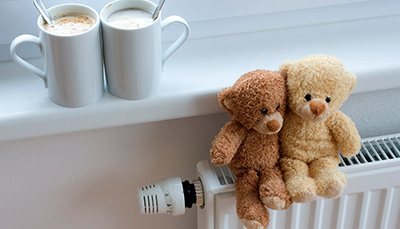

The heating system in an apartment building is a complex structure, the quality of which depends on correct engineering calculations even at the design stage.
The heated coolant must not only be delivered to the building with minimal heat loss, but also evenly distribute in rooms on all floors.
If the apartment is cold, then a possible reason is the problem with maintaining the required temperature of the coolant during the ferry.
Optimal and maximum
The maximum battery temperature has been calculated based on safety requirements. To avoid fires, the coolant must be 20 ° C colderthan the temperature at which some materials are capable of spontaneous combustion. The standard indicates safe marks in the range 65 to 115 ° C.
But, the boiling of the liquid inside the pipe is extremely undesirable, therefore, when the mark is exceeded at 105 ° C can serve as a signal to take measures to cool the coolant. The optimum temperature for most systems is at 75 ° C. If this rate is exceeded, the battery is equipped with a special limiter.
Minimum
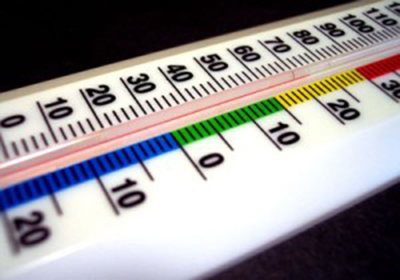

The maximum possible cooling of the coolant depends on the required intensity of heating the room. This indicator directly associated with the outside temperature.
In winter, in frost at –20 ° C, the liquid in the radiator at the initial rate at 77 ° C, should not be cooled less than up to 67 ° C.
In this case, the indicator is considered the normal value in the return at 70 ° C... During warming to 0 ° C, the temperature of the heating medium may drop up to 40–45 ° C, and the return up to 35 ° C.

